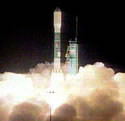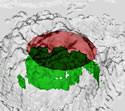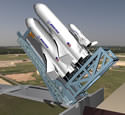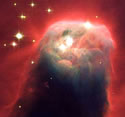An Ariane 4 rocket blasted off from Kourou, French Guiana Saturday morning at 0131 GMT (9:31 pm EDT Friday), carrying a French-built SPOT 5 remote sensing satellite. The spacecraft separated from the booster 19 minutes after launch and was placed into an 810-km Sun-synchronous orbit. The satellite will provide high-resolution images of the Earth’s surface at a resolution of 2.5 metres. This was Arianespace’s 200th rocket launch.
Delta Launches Aqua Satellite

Image credit: NASA
NASA’s newest Earth observation satellite launched Saturday aboard a Boeing Delta II rocket. Called Aqua, the satellite will gather data about global precipitation, evaporation and the cycling of water to help scientists understand if there’s any acceleration of the Earth’s water cycle and due to changing climate. The infrared sounder on board will measure the Earth’s atmosphere and help improve weather prediction.
NASA’s latest Earth observing satellite, Aqua, carrying the NASA Jet Propulsion Laboratory-managed Atmospheric Infrared Sounder instrument, successfully launched this morning at 2:55 a.m. Pacific Time. Aqua is dedicated to advancing our understanding of Earth’s water cycle and our environment. Launching the Aqua spacecraft marks a major milestone in support of NASA’s mission to help us better understand and protect our planet.
The Aqua spacecraft lifted off from the Western Test Range of Vandenberg Air Force Base, Calif., aboard a Delta II rocket. Spacecraft separation occurred at 3:54 a.m. Pacific Time, inserting Aqua into a 705-kilometer (438-mile) orbit.
“The Aqua project has truly been a team effort and we are very excited this morning,” said Aqua project manager Phil Sabelhaus at NASA’s Goddard Space Flight Center, Greenbelt, Md.
The primary goal of Aqua, as the name implies, is to gather information about water in Earth’s system. Equipped with six state-of-the-art instruments, Aqua will collect data on global precipitation, evaporation and the cycling of water. This information will help scientists all over the world to better understand Earth’s water cycle and determine if the water cycle is accelerating as a result of climate change.
JPL’s Atmospheric Infrared Sounder will measure Earth’s atmosphere and surface, allowing scientists to improve weather prediction and observe changes in Earth’s climate.
Aqua is the latest in a series of Earth Observing System spacecraft, following the Terra satellite launched in December 1999. Aqua will cross the equator daily at 1:30 p.m. as it heads north. The early afternoon observation time contrasts with the Terra satellite, which crosses the equator between 10:30 and 10:45 a.m. daily. Aqua’s afternoon observations, combined with Terra’s morning observations, will provide important insights into the daily cycling of key scientific parameters such as precipitation and ocean circulation.
Aqua is a joint project among the United States, Japan and Brazil. The United States provided the spacecraft and four of the six scientific instruments. In addition to the JPL-provided Atmospheric Infrared Sounder, the other U.S. instruments include the Moderate Resolution Imaging Spectroradiometer and the Advanced Microwave Sounding Unit, both provided by the Goddard center, and the Clouds and the Earth’s Radiant Energy System, provided by NASA’s Langley Research Center, Hampton, Va.
Japan’s National Space Development Agency provided the Advanced Microwave Scanning Radiometer, while the Instituto Nacional de Pesquisas Espaciais (the Brazilian Institute for Space Research) provided the Humidity Sounder for Brazil.
Aqua is part of NASA’s Earth Science Enterprise, a long-term research effort dedicated to understanding and protecting our home planet. Through the study of Earth, NASA will help to provide sound science to policy and economic decision makers so as to better life here, while developing the technologies needed to explore the universe and search for life beyond our home planet.
Original Source: NASA/JPL News Release
Shuttleworth Returns to Earth
South African space tourist Mark Shuttleworth returned to Earth safely on Sunday after spending 10-days in space, including a visit to the International Space Station. Shuttleworth, cosmonaut Yuri Gidzenko and Italian astronaut Roberto Vittori stepped from their Soyuz capsule near the Kazakhstan town of Arkalyk, and were greeted fondly by locals, friends and family. To remember his trip to space, Shuttleworth bought the Soyuz capsule and his flight suit.
IMAX Space Station 3D
If you’ve got an IMAX theatre nearby, you might want to check out their latest offering: IMAX Space Station 3D. They lugged one of those giant IMAX cameras up to the International Space Station and captured some of the life on 65mm film – in 3D! If you want more information, check out the special website at: IMAX Space Station
I haven’t seen the movie yet (maybe Chloe wants to go), but it sounds pretty cool. Let me know if you’ve seen it and have an opinion.
Fraser Cain
Publisher, Universe Today
Taking the Temperature of a Hurricane’s Eye

Image credit: NASA
When Hurricane Erin was beating up the North Atlantic last year, NASA researchers decided to take its temperature. Using a special aircraft, researchers dropped eight sensors into the area round the storm’s eye, a place that contains the most powerful winds and warmest temperatures. Using this data, they were able to create a three-dimensional image of the complete inner core.
Last year, NASA researchers took the temperature of the eye of Hurricane Erin to determine how a hurricane?s warm center fuels the strength of storms. The new data is helping scientists understand the inner workings of hurricanes at very high altitudes, and will improve future hurricane forecasts.
The researchers found that the warmest portion around a hurricane?s eye is approximately 3.5 miles high and that area in the eye corresponds with falling pressure, which is what causes the winds to spiral inward at destructive speeds.
During September 2001 while flying over the North Atlantic Ocean, scientists aboard NASA?s ER-2 aircraft dropped eight sensors into the area around Hurricane Erin?s eye, containing the strongest thunderstorms and winds, and warmest temperatures. Variations in temperatures within a hurricane provide clues about the storm?s intensity. For example, a warm center marked by a large temperature contrast compared to the rest of the hurricane is a sign of a strong storm.
The sensors measured temperature, air pressure and winds as they fell through the hurricane and transmitted their data back to the ER-2 aircraft. For the first time, the data allowed scientists to create a comprehensive 3-dimensional image of the complete inner core (including the eyewall and the eye) of a hurricane, giving scientists a better look at how heat from warm, rising air spreads out in the storm?s center. The warm, humid, rising air is the key to a hurricane?s power. This rising air draws in air from the surface to take its place, and creates winds.
?Scientists can obtain a detailed look at a hurricane?s heat engine (the warm temperatures that power a storm) by combining the aircraft data with that from satellites such as NASA?s Tropical Rainfall Measurement Mission,? said Jeff Halverson, a scientist from NASA?s Goddard Space Flight Center, Greenbelt, Md., and the University of Maryland Baltimore County.
?The data from the sensors and the satellite have given us a view of the eye?s warm air, the rain clouds that warm the air through condensation, and the spiraling surface winds which in turn create the rain clouds. We have assembled all this data in a three dimensional rendition of the hurricane which is akin to taking a detailed ?CAT scan? of the storm,? Halverson said.
?We found that this storm had a very warm eye, from the ocean to the top of the lower atmosphere at around 10 miles altitude,? said Halverson. The warmest part of Erin?s eye was almost 21 degrees (Fahrenheit) warmer than the surrounding air, a dramatic difference from the air around it. Above 7.5 miles high, the eye?s temperature dropped quickly to the same temperature as the air outside the eye.
The warming temperatures within the hurricane?s eye make the air lighter, so air pressure eases on the surface and falls. When air is cold, the air molecules are dense, and air is heavier. The falling pressure in the hurricane?s eye is what creates swirling destructive winds.
The experiment also discovered that strong rising air currents in Erin caused the tropopause (top of the lower atmosphere) to ?bubble up? or bend, south of the eye?s center. This is indicative of the strength of Hurricane Erin, which was a Category 3 storm at this time.
There are five categories in which hurricanes are classified, the fifth being the most devastating. Category 3 hurricanes, such as Erin have winds between 111-130 mph, and can bring a storm surge of water (wind driven water above tide level) between 9-12 feet to shorelines.
Halverson will be presenting these findings at the AMS Hurricane and Tropical Meteorology Conference in San Diego, Calif. on Tuesday, April 30, 2002 at 9:00 a.m. Pacific time in a session titled ?Thermal Structure of Hurricane Erin?s Core Using Dropsonde Data From 68,000 Feet and Comparison with AMSU Satellite Measurements.?
Original Source: NASA News Release
NASA Gets Closer to Space Shuttle Replacement

Image credit: Boeing
NASA believes it’s one step closer to replacing the aging space shuttle fleet. After analyzing hundreds of potential vehicle concepts, the Space Launch Initiative (SLI) has short listed the potential suppliers down to three teams: Boeing, Lockheed Martin, and Orbital Sciences/Northrop Grumman. Each team has provided several ideas that fulfill the requirements of the SLI: carry humans and satellites into orbit; carry government or commercial payloads; be operated by the private industry; and launch at a fraction of the cost of the space shuttle.
NASA is another step closer to defining the next-generation reusable space transportation system and successor to the Space Shuttle.
The Space Launch Initiative (SLI), a NASA-wide effort defining the future of human space flight, has completed its first milestone review ? resulting in a narrower field of potential candidates for the nation’s second-generation reusable space transportation system.
“To use the resources afforded by space, it’s critical to increase reliability and safety while at the same time reducing the cost of space transportation,” said Art Stephenson, director of NASA’s Marshall Space Flight Center, Huntsville, Ala., which manages the SLI for the Office of Aerospace Technology. “The Space Launch Initiative is doing the groundwork to accomplish these goals and create a second-generation launch system.”
“We’re not just designing a launch vehicle,” added Dennis Smith, also of Marshall, program manager of the Space Launch Initiative. “We’re designing the complete system.”
The recent review, called the Initial Architecture Technology Review, analyzed and evaluated competing second-generation reusable space transportation architectures and technologies against NASA and commercial mission requirements, as well as safety and cost goals.
Architecture refers to the complete transportation system design ? that is, the vehicles and their components that fly into space, as well as the ground operations needed for launch. The transportation system design includes an Earth-to-orbit reusable launch vehicle (the Space Shuttle is the first-generation reusable launch vehicle); on-orbit transfer vehicles and upper stages to put satellites into orbits; mission planning; ground and flight operations; and support infrastructure, both on orbit and on the ground.
Three contractor architecture teams ? The Boeing Company of Seal Beach, Calif.; Lockheed Martin Corp. of Denver; and a team including Orbital Sciences Corp. of Dulles, Va., and Northrop Grumman of El Segundo, Calif. ? presented dozens of potential architectures for review. Following the review, each retained a handful of possible candidates for the nation’s next-generation reusable space launch system.
The review allows the Space Launch Initiative to target investments and support what the program manager called the “up-front, homework part of the program” ? furthering technologies to aid in the development of a second-generation reusable launch vehicle. Another review will be held in November to further narrow potential space transportation architectures to two or three choices.
“We’re going to seek the final and best ideas from industry, academia and government,” said Smith. With the final selection of an architecture, full-scale development of a reusable launch vehicle could begin around the middle of this decade.
Since propulsion systems require a long lead-time to design, develop, test and evaluate, it isn’t surprising that propulsion analysis was a chief driver through the recently completed review activity.
“We spent a lot of time analyzing propulsion technologies,” said Smith. “Among the outcomes is a focus on kerosene-fueled main engines.” This focus is based on studies, conducted by the architecture contractors that examine performance of competing technologies in safety, reliability, cost and operability. Studies indicated that kerosene main engines have excellent potential to meet government and commercial needs. The second-generation vehicle will have a two-stage-to-orbit propulsion system based on engines fueled by all kerosene, all hydrogen or a combination of kerosene and hydrogen.
Dependable, long-life engines, along with crew escape and survival systems, and long-life, lightweight integrated airframes are among the Space Launch Initiative’s highest priorities. Each greatly impacts the program’s bottom line of increased safety, reliability and cost effectiveness.
Original Source: NASA News Release
First Pictures from Hubble’s New Camera

Image credit: Hubble
NASA provided the first pictures today from the newly refurbished Hubble Space Telescope. Among the four new images unveiled to the public today included colliding galaxies, and several nebulas. The Advanced Cameral for Surveys was installed by the crew of the space shuttle Atlantis just a few months ago, and seems to be working well. Operators expect it will be ten times more efficient than the observatory’s previous camera – so far, so good.
“Remarkable, breathtaking” are words jubilant astronomers are using to describe the first four views of the universe taken by the Hubble Space Telescope’s new Advanced Camera for Surveys, released by NASA today.
The new camera was installed on Hubble by astronauts during a shuttle mission last March, the fourth Hubble Space Telescope servicing mission. During five of the most challenging spacewalks ever attempted, the crew successfully upgraded the orbiting telescope with the new camera, a new power unit, new solar arrays and an experimental cooling unit for an infrared camera. Hubble managers say the orbiting telescope has been operating superbly since the servicing mission.
“Today marks the beginning of a new era of exploration with Hubble,” said Dr. Ed Weiler, Associate Administrator for Space Science at NASA Headquarters, Washington. “Our team of scientists and engineers on the ground and the astronauts in space once again did the impossible. After 12 years in space, Hubble not only was given a major overhaul, its new camera has already shown us that, even after 12 years of great science and astounding images, we haven’t seen anything yet.”
Among the suite of four “suitable-for-framing” Advanced Camera for Surveys (ACS) science-demonstration pictures released today is a stunning view of a colliding galaxy, dubbed the “Tadpole,” located 420 million light-years away. Unlike textbook images of stately galaxies, the “Tadpole” ? with a long tail of stars ? captures the essence of a dynamic, restless and violent universe, looking like a runaway pinwheel firework.
“The ACS is opening a wide new window onto the universe. These are among the best images of the distant universe humans have ever seen,” said astronomer Holland Ford of Johns Hopkins University in Baltimore, lead scientist in the camera’s seven-year development.
The camera’s tenfold increase in efficiency will open up much anticipated new capability for discovery. “ACS will allow us to push back the frontier of the early universe. We will be able to enter the ‘twilight zone’ period when galaxies were just beginning to form out of the blackness following the cooling of the universe from the big bang,” said Ford.
The ACS is a camera of superlatives. It is expected to surpass the sensitivity of the largest ground-based telescope to eventually see the very faintest objects ever recorded. The camera delivers a panoramic crispness comparable to that of a wide-screen movie, containing 16 million picture elements (megapixels) per image. By comparison, digital photos from typical consumer cameras are 2 to 4 megapixels.
The ACS image of the Tadpole illustrates the dramatic gains over the Wide Field Planetary Camera 2 resulting from doubling the area and resolution, and demonstrates a five- fold improvement in sensitivity. An unexpected bonus is the enormous number of galaxies in the new Hubble image beyond the Tadpole galaxy, giving it an appearance like the galaxy- filled Hubble Deep Field (HDF) image, taken in 1995. However, the ACS picture was taken in one-twelfth the time it took for the original HDF. Like the Hubble Deep Field, the ACS galaxies contain myriad shapes that are snapshots of galaxies throughout the universe’s 13 billion-year evolution. The ACS images are so sharp astronomers can identify “building blocks” of galaxies, colliding galaxies and extremely distant galaxies in the field ? an exquisite sampler of galaxies.
“The ACS will let us obtain the deepest image of the universe for the foreseeable future,” added astronomer Garth Illingworth of the University of California, Lick Observatory, Santa Cruz, the deputy leader for the camera team.
The other pictures include a stunning collision between two spiral galaxies, dubbed “the Mice,” that presage what might happen to our own Milky Way several billion years in the future when it collides with the neighboring galaxy in the constellation Andromeda. Computer simulations, made by Joshua Barnes of the University of Hawaii and John Hibbard of the National Radio Astronomy Observatory, show that we are seeing the collision of the Mice approximately 160 million years after their closest encounter. Running the simulations forward in time shows that the two galaxies will eventually merge. A similar fate may await the Milky Way and the Andromeda galaxy.
Looking closer to home, ACS imaged the “Cone Nebula,” a craggy-looking mountaintop of cold gas and dust that is a cousin to Hubble’s iconic “pillars of creation” in the Eagle Nebula, photographed in 1995.
Peering into a celestial maternity ward called the M17 Swan Nebula, the ACS revealed a watercolor fantasy-world tapestry of vivid colors and glowing ridges of gas. Embedded in this crucible of star creation are embryonic planetary systems.
In addition to the ACS, spacewalking astronauts installed a new high-tech mechanical “refrigerator” on Hubble during the servicing mission. This “cryocooler” has successfully pumped most of the heat out of the interior of the Near Infrared Camera and Multi-Object Spectrometer (NICMOS), achieving and maintaining to within a few hundredths of one degree the target temperature for neon gas passing through the instrument of 70 degrees Kelvin (minus 203 degrees Centigrade or minus 333 degrees Fahrenheit).
Engineers are now in the process of checking out the operation of the resuscitated NICMOS instrument. By early June, scientists expect to release the first astronomical images taken with the NICMOS since 1998, when it was still being cooled by a rapidly depleting block of solid nitrogen ice.
The new rigid solar arrays, working with the new Power Control Unit, are generating 27 percent more electrical power than the previous arrays. This doubles the electrical power that can be allocated to the scientific instruments on Hubble. The new reaction wheel is operating normally. Nearly a month ago, the Space Telescope Imaging Spectrograph and the Wide Field and Planetary Camera 2 resumed science observations.
“This servicing mission has turned out to be an extraordinary success,” said Preston Burch, Hubble Project Manager at NASA’s Goddard Space Flight Center in Greenbelt, Md. “It was the most difficult and complicated Hubble servicing mission attempted to date and our observatory came through it with flying colors.”
Soyuz Docks with Space Station
South African space tourist Mark Shuttleworth and his two crewmates arrived at the International Space Station when their Soyuz capsule docked on Saturday. The three visitors entered and were greeted with big hugs by the station’s residents. A few hours later Shuttleworth was congratulated by South African President Thabo Mbeki for his achievement of becoming the first African in space.
Soyuz Launches with Space Tourist
Space tourist Mark Shuttleworth is finally on his way to visit the International Space Station. Shuttleworth and his companions, Yuri Gidzenko and Roberto Vittori, lifted off from the Baikonur cosmodrome in Kazakhstan at 0626 GMT (2:26 am EDT) on board a Russian Soyuz rocket. The Soyuz will dock with the International Space Station on Saturday. This team will visit the station for a week, and then return to Earth in the replacement Soyuz currently docked.
Book Review: Bad Astronomy by Phil Plait
Astronomer Phil Plait has found a great niche for himself – debunking bad science, specifically Bad Astronomy. He’s been at it on the web for years, and it came as no surprise to me when I found out there was a book deal in the works.
Astronomer Phil Plait has found a great niche for himself – debunking bad science, specifically Bad Astronomy. He’s been at it on the web for years, and it came as no surprise to me when I found out there was a book deal in the works.
Bad Astronomy: Misconceptions and Misuses Revealed, from Astrology to the Moon Landing “Hoax” is exactly what it sounds like. For 260ish pages Phil takes a look at many of the common misconceptions that have plagued astronomy for years.
The first half of the book is interesting reading, but it’s more of a science book. Phil looks at many of the commonly misunderstood concepts in astronomy and sets the record straight. I’d like to think I know a little about astronomy, so I was pretty surprised to learn I was misinformed about many aspects of the basics: tides, meteors, gravity.
It’s in the second half of the book where Plait really hits his stride as he examines some of the “bad astronomy” hatched more recently: Apollo moon landing hoaxes, UFOs etc. Because the culprits are still spinning out the bad science, Phil firmly debunks their “theories”. I especially enjoyed the Top Ten Examples of Bad Astronomy in Hollywood.
If I had a complaint, it’s that Phil spends a little too much time explaining how to balance an egg in any season (a whole chapter!, but I guess he was trying to make a point). Seriously, though, it’s a great book, not Bad Astronomy at all.
Click here to find out more from Amazon.com.
Fraser Cain
Publisher, Universe Today
